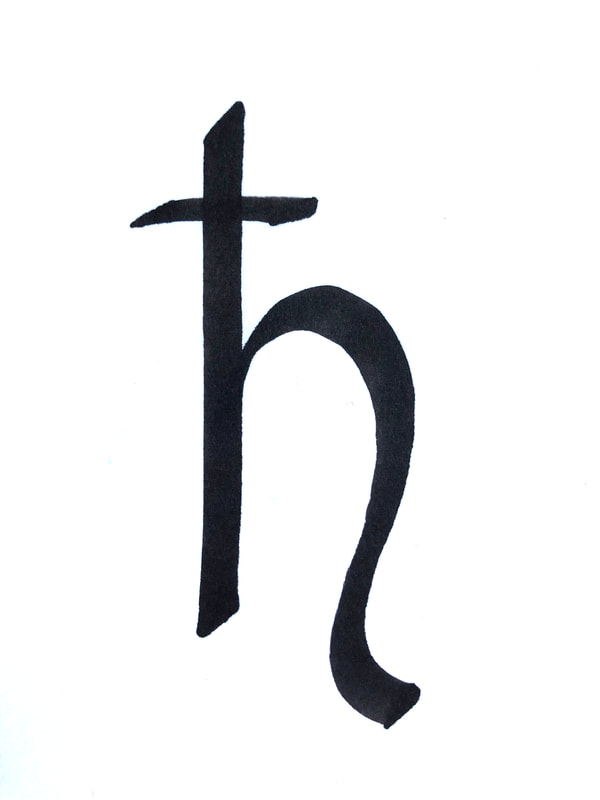|
Today we come to the final day of our journey through the days of planetary magic: Saturday, the day of Saturn. Attuning with Saturn can sometimes bring up difficult feelings—of limitation, constraint, scarcity, or even fear. But in my practice, I’ve found that even these difficult feelings have important lessons to teach us, and Saturn is one of our great teachers. In Hellenistic astrology, Saturn is described as the malefic of the diurnal (day) sect. Saturn rejects and excludes. It is the planet associated with limits, boundaries, structures, the passage of time, and the wisdom that comes from age and solitude. Saturn teaches us discipline and patience. If you’ve heard of—or been through—your “Saturn return,” this is when Saturn returns to the place it was in the sky at the time you were born. This happens approximately every 29 years or so, and each cycle, Saturn comes back around to hold us accountable to difficult, life-long lessons. Saturn rules the signs of Capricorn and Aquarius, and is exalted in the sign of Libra. For today—or any Saturday—you might make a small altar for Saturn with the things you have available. You can look to the list of correspondences below for the kinds of colors, stones, numbers, and tarot cards you might incorporate. Add things that you associate with Saturn—maybe a clock or an hour glass, perhaps photos or objects that have been handed down to you from your ancestors, things that are old or antique, or things that intimate solitude. Once you build your altar, take some time to be with it as an aesthetic experience. Notice how being with this altar makes you feel. Drop your attention down into your body and observe what sensations arise as you spend time with the objects that you’ve gathered for Saturn. Saturn is currently visible in the night sky. It has a dull, brownish/yellowish glow. I usually locate it in relation to Jupiter—Jupiter is bright and shining in Sagittarius, and Saturn is around 30º to the east of Jupiter. If it’s a clear night, perhaps you might go for a walk and try to spot Saturn, observing what it feels like to stare into its light. Whether you’re working with or without an altar, whether you go out to see Saturn in the sky, I invite you to take some time to meditate with Saturn. It could be five minutes, ten minutes, or longer. Visualize Saturn in your mind’s eye (you can look up pictures of the planet if you don’t know what it looks like), or visualize the glyph for Saturn. Notice what your body feels like as you imagine Saturn. Remember or call up experiences in which you felt acutely aware of the passage of time. Remember experiences in which you felt challenged to take responsibility, to act with maturity, and to be disciplined in your choices. Recall times when you have felt limited or restricted by circumstances you couldn’t control, structures that resisted any attempt to change them. Notice what these memories feel like in your body, not just as thoughts in your mind. In meditations like this, I also work with mantras coming from the yoga tradition. For working with Saturn, I use the mantra: “Om Sri Shanaishwaraya Namaha.” I use a mala and repeat the mantra 108 times. I also sometimes use mudra, described below. However you spend your time meditating with Saturn—repeating a mantra, recalling experiences that you associate with Saturn’s significations, gazing at Saturn in the night sky, or sitting at your alter—tune in to the sensations that begin to accumulate. These could be physical, emotional, or more subtle energetic shifts in your awareness. The practice is for Saturn to become more than just an abstract symbol or something that you think of as “out there” in space. As you begin to notice what Saturn feels like within your body, this becomes a state that you can return to and work with in your magic, and how you understand Saturn astrologically—in your birth chart or in its transits—will begin to take on more embodied significance as well. Saturn Day: Saturday Number: 3 Colors: black and grey Metals: “Iron and part of gold” (Picatrix) Stones: “diamond, onyx, cameo, and azebehe that is black and clear, and iron ore and magnesia and ruby in part, and yellow mascasite, and also hematite” (Picatrix) Chakra: Muladhara, the Root Chakra Mantra: Om Sri Shanaishwaraya Namaha Mudra: The middle finger is associated with Saturn, so I use Shunya Mudra—folding the middle finger toward the center of the palm, bringing tip of thumb to the top of the middle finger together, with other fingers extended. Tarot: The Hermit (In the Golden Dawn tradition, Saturn was associated with The World card.) Sources:
Kaitlin Coppock, “Planetary Magic: A Beginner’s Guide,” WellBeing Astrology 2020, editor Kelly Surtees, Universal Media Co, 2019: 92-95. Austin Coppock, “Intro to Planetary Magic,” https://austincoppock.com/shop/intro-to-planetary-magic-course/[online course]. Richard Fish and Ryan Kurczak, The Art and Science of Vedic Astrology: The Foundation Course (Asheville Vedic Astrology, 2012). Cain Carroll and Revital Carroll, Mudras of India (London: Singing Dragon, 2013). Gertrud Hirschi, Mudras: Yoga in your Hands (York Beach, Maine: Samuel Weiser, Inc, 2000). Thomas Ashley-Farrand, Healing Mantras: Using Sound Affirmations for Personal Power, Creativity, and Healing (New York: Ballantine Books, 1999). Richard Palmer, “Delving Into Tarot and Astrology in the Golden Dawn Tradition,” Biddy Tarot, https://www.biddytarot.com/tarot-astrology-golden-dawn/. Joe Rao, “When, Where and How to See the Planets in the 2019 Night Sky,” December 27, 2018, https://www.space.com/39240-when-to-see-planets-in-the-sky.html. If you missed the previous posts in this series, you can find them here: The Sun The Moon Mars Mercury Jupiter Venus
0 Comments
Your comment will be posted after it is approved.
Leave a Reply. |
AuthorMichael J. Morris is a witch, an astrologer, a tarot reader, an artist, a writer, and a teacher. Categories
All
Archives
April 2024
|
- Home
- About
- Bookings
- Offerings
- Events
- Tutoring and Mentorship
-
Downloads
- Transits and Transgender Liberation
- Feminist Astrology and the Moon
- Feminist Astrology: Mars, Violence, and War
- Celestial Kinship
- Introduction to Ritual Workshop + Beltane Ritual
- Minor Asteroids in the Birth Chart and Ritual
- Astrology Guide for 2022
- The Atomic Age, Urgency, Danger, and Kinship: Astrology and Climate Collapse
- Asteroids in Astrology: Nuance, Subtlety, and Direction
- Tarot Workshop with Michael J. Morris
- Astrology as an Artistic Practice: As It Is Made, So It Makes
- Astrology Guide for 2021
- Celestial Corporeality: Astrology and the Body
- Astrology Consultations as Feminist Praxis
- Embodying Astrological Archetypes
- Resources
- Blog
- Testimonials
- Policies
- Gratitude
Copyright © 2020






 RSS Feed
RSS Feed